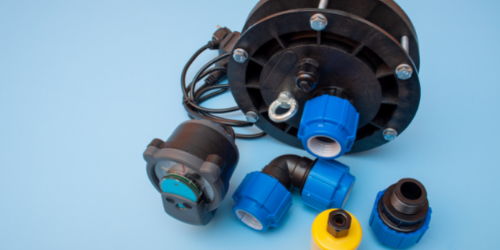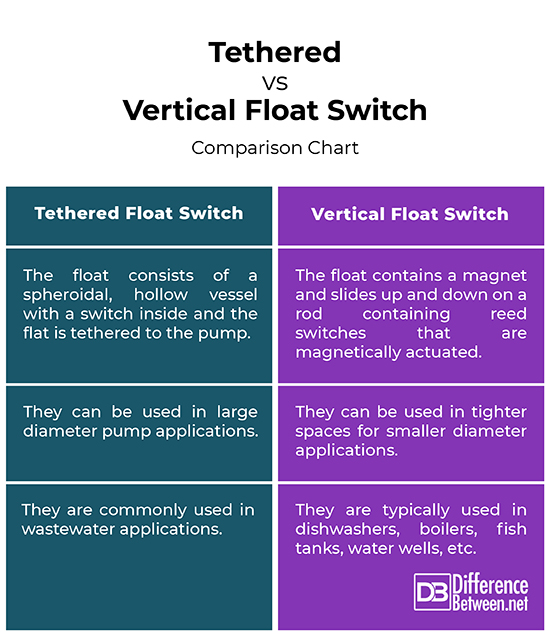Difference Between Tethered and Vertical Float Switch
A sump pump is a pump that removes water entering the building because of sewage line backups, water main breakage, or plumbing system damage within the building. It is a critical item that reduces the risk of water damage to the basements of your homes. But, no matter how heavy-duty a pump is, it is only as good as the switch mechanism that operates it. Two of the most common switch types are the tethered float switch and the vertical float switch.

What is Tethered Float Switch?
A tethered float switch is one of the most common switch types used for sump pumps. As the name suggests, it has a floating element that is tethered to the pump and it swings in an arc with changes in the water level. A tethered float consists of a spheroidal, hollow vessel with a switch inside. When lifted, the float changes position and actuate the switch. As the water fills the basin, the tethered float ball connected to the power cord swings upwards. As the float ball reaches the top, it activates the float switch which turns on the pump. The pump then empties the basin. When the float ball reaches the bottom it deactivates the float switch, which turns of the pump. However, the float must be replaced periodically (2 to 3 years) because the electric cable flexes and wears out.

What is Vertical Float Switch?
A vertical float switch is one of the simplest switch types from a construction point of view and is suitable for a vertical placement. The float contains a magnet and slides up and down on a rod containing reed switches that are magnetically actuated. The float travels up and down the fixed vertical rod, eliminating any side to side movement. As the water fills the basin the vertical float ball goes up the flow route and when it reaches the top, it activates the float switch which turns on the pump. The pump runs and empties the basin and when the float ball reaches the bottom, it deactivates the float switch, eventually turning off the pump. They are mostly used in very tight diameter applications such as basement sump pumps and crawlspace pumps.
Difference between Tethered and Vertical Float Switch
Mechanism
– A float switch is a critical device that monitors the water level in a tank or sump. It is designed to provide automatic control of AC and DC pump motor magnetic starters and automatic direct control of light motor loads. A tethered float switch is a common switch mechanism with a float that is tethered to the pump. The float consists of a spheroidal, hollow vessel with a switch inside. A vertical float, on the other hand, contains a magnet and slides up and down on a rod containing reed switches that are magnetically actuated.
Working
– A tethered float switch consists of a cord and a float ball. As the water fills the basin, the tethered float ball connected to the power cord swings upwards. As the float ball reaches the top, it activates the float switch which turns on the pump. The pump then empties the basin. When the float ball reaches the bottom it deactivates the float switch, which turns of the pump. A vertical float travels up and down the fixed vertical rod; as the water fills the basin the vertical float ball goes up the flow route and when it reaches the top, it activates the float switch which turns on the pump.
Applications
– Tethered floats are among the least expensive switch types commonly used in large diameter sump pumps and wastewater applications with some degree of success. Tethered floats are available in pump up and pump down styles. Vertical floats are typically installed on the side of the basin or discharge piping. They are commonly used for high temperature and pressure applications, such as dishwashers, boilers, fish tanks, water wells, etc.
Tethered vs. Vertical Float Switch: Comparison Chart

Summary
In a nutshell, float switches are commonly used to control sump pumps. A plastic float ball is attached to the top of the pump by a short cable or a tether. When the water level goes up, the float rises and when it reaches the end of the tether, it floats vertically. In the vertical position, a simple inside the float will activate and start the pump. When the sump is emptied, the float will sink to a low level, and the change in position will break the circuit and stop the pump. With a vertical float switch, the float rides up and down on a rod. With a tethered float switch, the float ball swings in an arc as the water level goes up and down.
Is a vertical float switch better?
Vertical float switches are ideal for small diameter basins that aren’t very deep and typically used for high temperature and pressure applications, such as dishwashers, boilers, fish tanks, water wells, etc.
What is the best type of switch on a sump pump?
Electronic switches are the most reliable and efficient switch types that are ideal for sump pump applications because they do not have any moving parts.
What is a tethered float on a sump pump?
A tethered float consists of a spheroidal, hollow vessel with a switch inside. When lifted, the float changes position and actuate the position. A tethered float is commonly used in wastewater applications.
Which float switch is best?
Determining which float switch is ideal for an application largely depends on the type of tank to be used. Two of the most common switch types are vertical and horizontal float switches.
- Difference Between Caucus and Primary - June 18, 2024
- Difference Between PPO and POS - May 30, 2024
- Difference Between RFID and NFC - May 28, 2024
Search DifferenceBetween.net :
Leave a Response
References :
[0]Herman, Stephen L. Electric Motor Control. Massachusetts, United States: Cengage Learning, 2014. Print
[1]Simmons, Phil and Ray C. Mullin. Electrical Wiring Commercial. Massachusetts, United States: Cengage Learning, 2017. Print
[2]Jones, Garr M., et al. Pumping Station Design: Revised 3rd Edition. Oxford, United Kingdom: Butterworth-Heinemann, 2011. Print
[3]Image credit: https://www.canva.com/photos/MAC6MTc1xNs-floats/
[4]Image credit: https://www.canva.com/photos/MADz9tfuSAI-the-head-is-sealed-downhole-a-small-weight-for-a-float-switch-a-pressure-switch/
